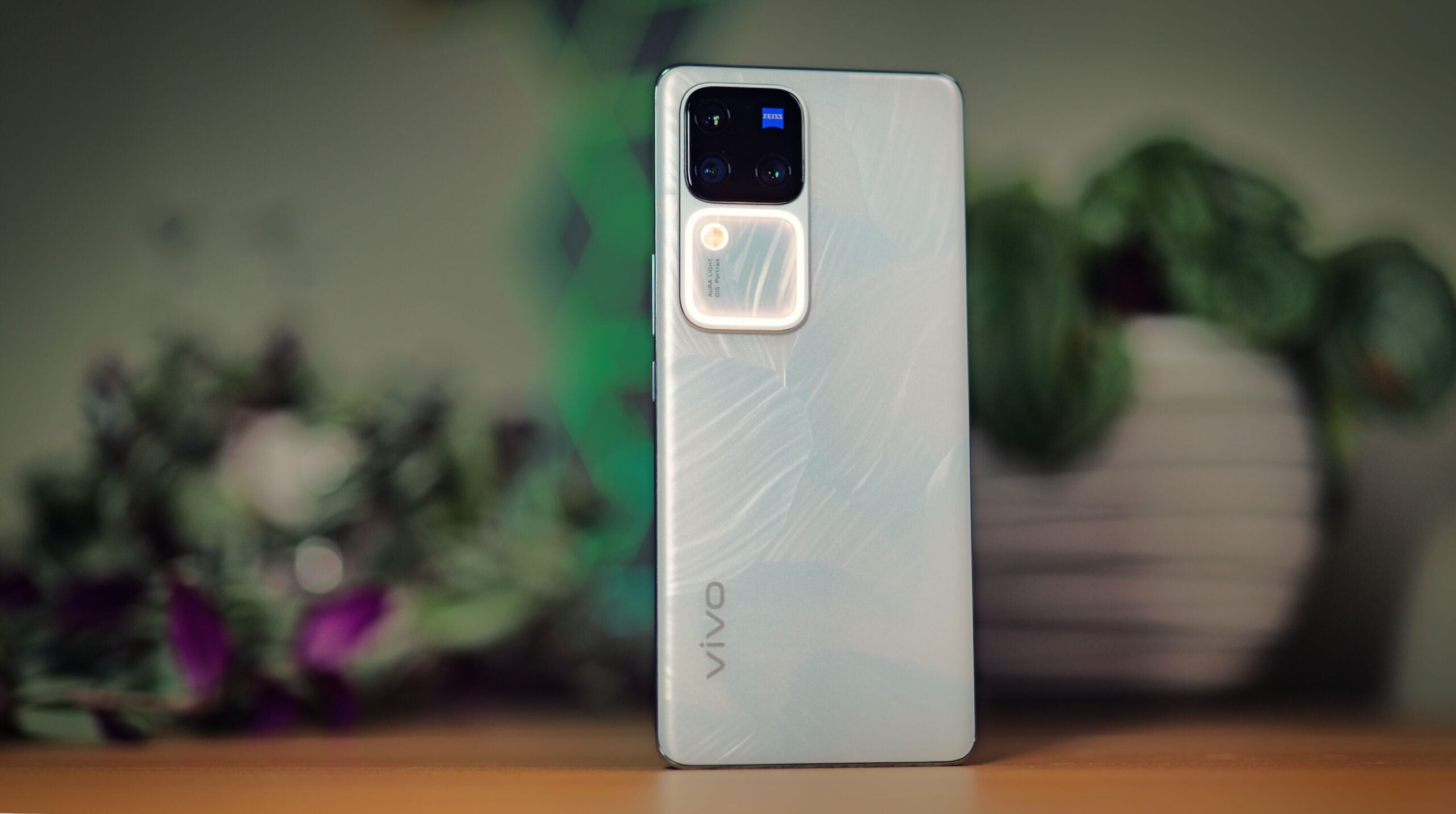Oppo Find X7 Ultra Review
A stunning phone that offers the complete package






Verdict
The Oppo Find X7 Ultra impresses on all fronts. It has a beautiful design, excellent screen, powerful performance and stunning cameras. It’s not likely to get an international launch, though, and the Chinese software is sure to cause frustration.
Pros
- One of the best camera systems available
- Gorgeous design
- Powerful and speedy
Cons
- Only available in China
- Poor software localisation
- Lots of bloatware
Key Features
- Incredible camerasThe Oppo Find X7 Ultra has quad 50MP cameras on the rear and it’s the first phone to boast dual periscope telephoto cameras. This means you can capture amazing shots at a wide variety of focal lengths.
- Bright high-resolution displayAble to output a whopping 4500 nits at peak, this panel is one of the brightest around. It looks great, too, with a high-resolution panel and Dolby Vision support.
- Serious performanceThe Oppo Find X7 Ultra sports Qualcomm’s flagship chip, the Snapdragon 8 Gen 3. It’s up there with the fastest phones around, and perfect for gaming on the go.
Introduction
The Oppo Find X7 Ultra is Oppo’s camera-focused flagship smartphone for 2024.
It’s currently only available in China, though dedicated Oppo fans can easily import one if they’re swayed by the impressive camera and slick design. And with specs like this, that’s a real possibility. Oppo has thrown everything into this device, making it truly worthy of the Ultra moniker.
I’d love to see this phone get a wider release, but it seems that it’s destined to stay in China, as Oppo has not announced any plans to bring it to international markets. This means that, if you do buy one, you’ll have to jump through some hoops to get access to Google’s Play Store and you’ll be stuck with some untranslated software elements.
I wanted to find out if it’s worth the hassle, and also how it compares to camera-focused flagships that have made their way to Europe, like the Vivo X100 Pro. So, after living with it as my main device for over a week, here’s what I found out.
Note: We won’t be adding a star rating to our full review unless the phone becomes available to buy in the UK and Europe.
Design
- Gorgeous two-tone design
- OnePlus-style alert slider
- IP68 rated
I think the Oppo Find X7 Ultra might just be one of the best-looking smartphones ever made. Of course, style is subjective, and it won’t be to everyone’s taste, but I absolutely adore the look of this phone.
I was sent the Ocean Blue colourway for testing, which has a navy vegan leather covering on the lower portion of the phone, contrasted by a high-gloss white finish on the top. In the middle, there’s a massive circular camera array, which is finished in a metallic silver colour. It’s a very nautical look, and it makes me think of a high-end yacht. Presumably, exactly what Oppo was going for, with a name like Ocean Blue.
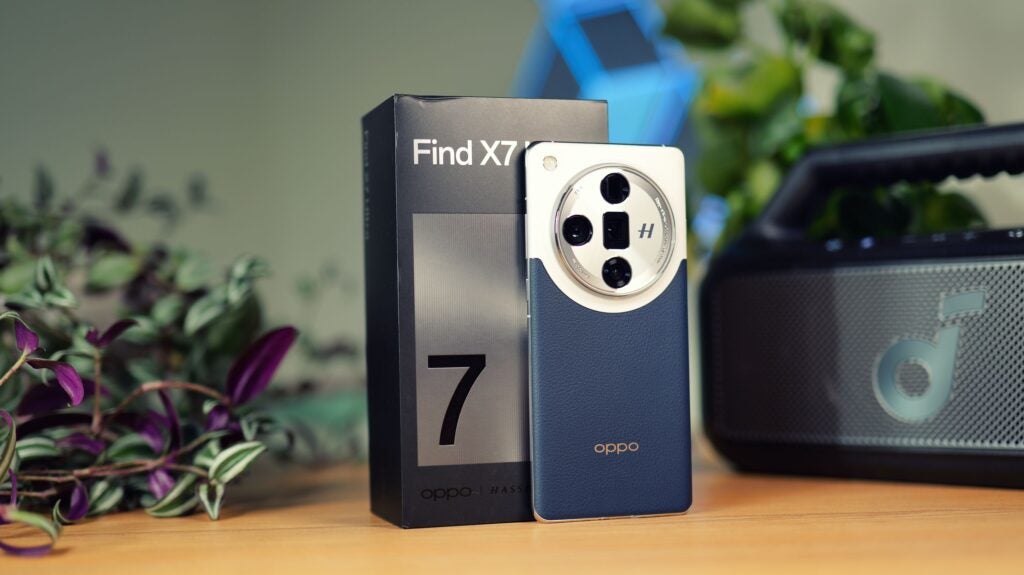
Sepia Brown is a similar colourway, only it swaps the Navy leather-effect portion for a brown one, and it looks similarly impressive. However, if you prefer something less flashy, the Tailored Black option tones things down a bit. On that variant, everything, including the camera array, is in black or dark grey. Very professional, if a little less exciting.
It’s a big phone, and it’s fairly weighty at around 221 grams, but it’s comfortable to hold. The front and rear both feature curved edges, and this makes the phone feel slimmer than it actually is. I found that resting my forefinger on the edge of the large camera bump helped me keep a hold of it, too.
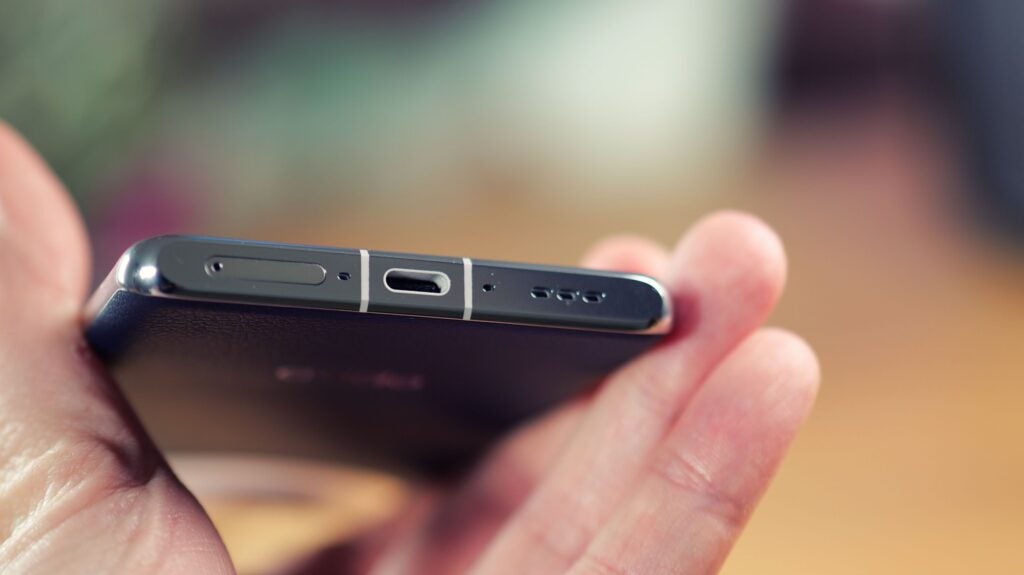
On the left-hand side, there’s an alert slider, just like the one on the OnePlus 12, so you can quickly switch to silent when needed. It has three positions, and the uppermost is something called VIP mode, which disables the phone’s cameras and microphone. This could be handy if you’re some kind of secret agent.
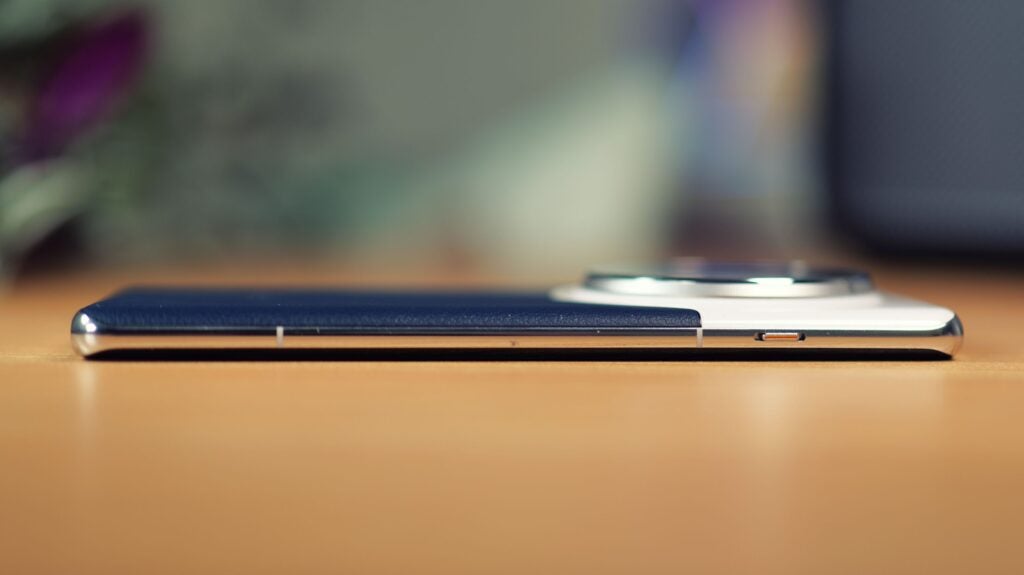
The phone has an IP68 rating for dust and water resistance, which is about as good as it gets. So you can happily snap photos of your trips to the beach without worrying about damaging it.
Screen
- 6.82-inch 120Hz AMOLED screen
- 4500 nits peak brightness
- 2160Hz PWM dimming
The Oppo Find X7 Ultra has a large display with a high resolution of 1440×3168. It’s also one of the brightest panels around, able to boost to an eyeball-searing 4500 nits at peak. In normal use, it won’t get close to that, but it’s bright enough to compete with the sunlight, even if you’re trekking through the Sahara.
It has curved edges, but it’s a tighter curve than most. The vast majority of the time, it almost feels like a flat display, and it’s only when you use gesture navigation to pull from the edges that you really interact with the curve. I think this is a nice middle ground, as it still serves to make the phone look and feel slimmer, but I had fewer accidental interactions with the curved parts of the display.

The panel supports Dolby Vision and HDR10+, however, Netflix refused to play in HDR on my test unit, as it lacked the correct DRM certification. You can shoot videos in Dolby Vision using the native camera app, though, so it still serves a purpose.
In applications where HDR functions as expected, like YouTube, the display looks stunning. You get the amazing contrast that we’ve become accustomed to from the OLED panel, while the highlights can boost so bright that you almost wince. It’s very impressive.
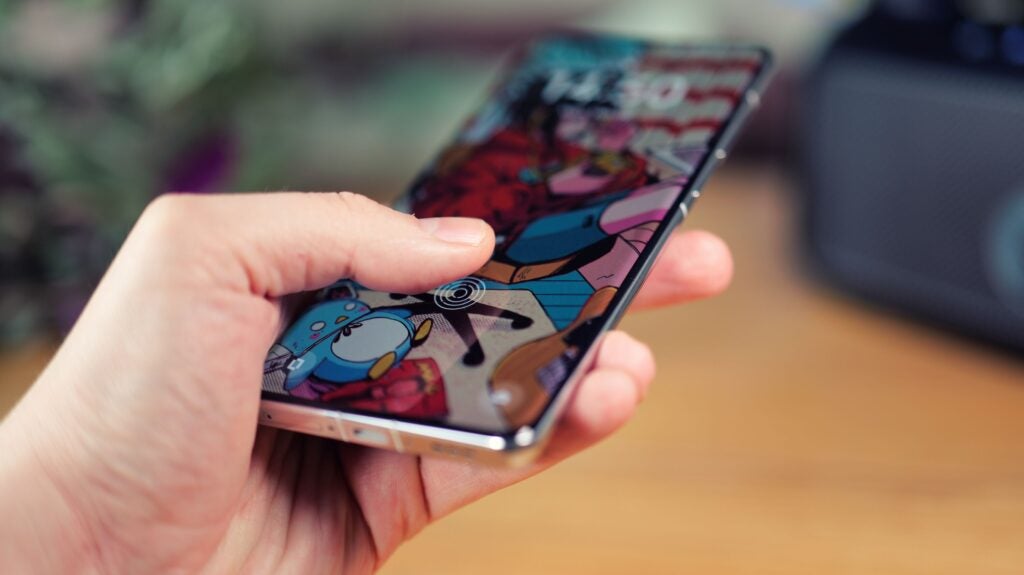
When it comes to adjusting the colour rendition, there’s a good amount of customisation available. The OS gives you three profiles to choose between – Natural, Pro and Vivid – and you can tweak the temperature and tint of each using a colour wheel. There are also eye-care options available, and even an image sharpener and SDR to HDR conversion, if you want to make lower-quality sources look better.
Cameras
- Quad 50MP camera array
- Dual periscope telephoto lenses
- Second-gen Sony 1-inch sensor
As evidenced by the gigantic camera bump with proud Hasselblad branding, the Oppo Find X7 Ultra packs some serious camera hardware.
Around the back, you get four 50MP sensors. The main sensor is the new Sony LYT-900, which is a stacked 1-inch type sensor. This means that it’s more sensitive to light than its predecessor, while drawing less power, and is still one of the largest sensors you’ll find in any smartphone. It has an f/1.8 aperture and a 23mm equivalent focal length.

The massive main sensor is joined by an f/2.0 14mm ultrawide, an f/2.6 65mm zoom and an f/4.3 135mm telephoto. The other sensors are comparatively small, but the 65mm (3x) is still quite sizable at 1/1.56-inch. Around the front, the punch-hole selfie camera has a 32MP resolution, an f/2.4 aperture, and also benefits from autofocus.
These cameras are capable of taking some stunning images, and there’s great consistency in the colour rendition of each lens. The main camera is very comparable to the one on the Vivo X100 Pro, and the Find X6 Pro, too.
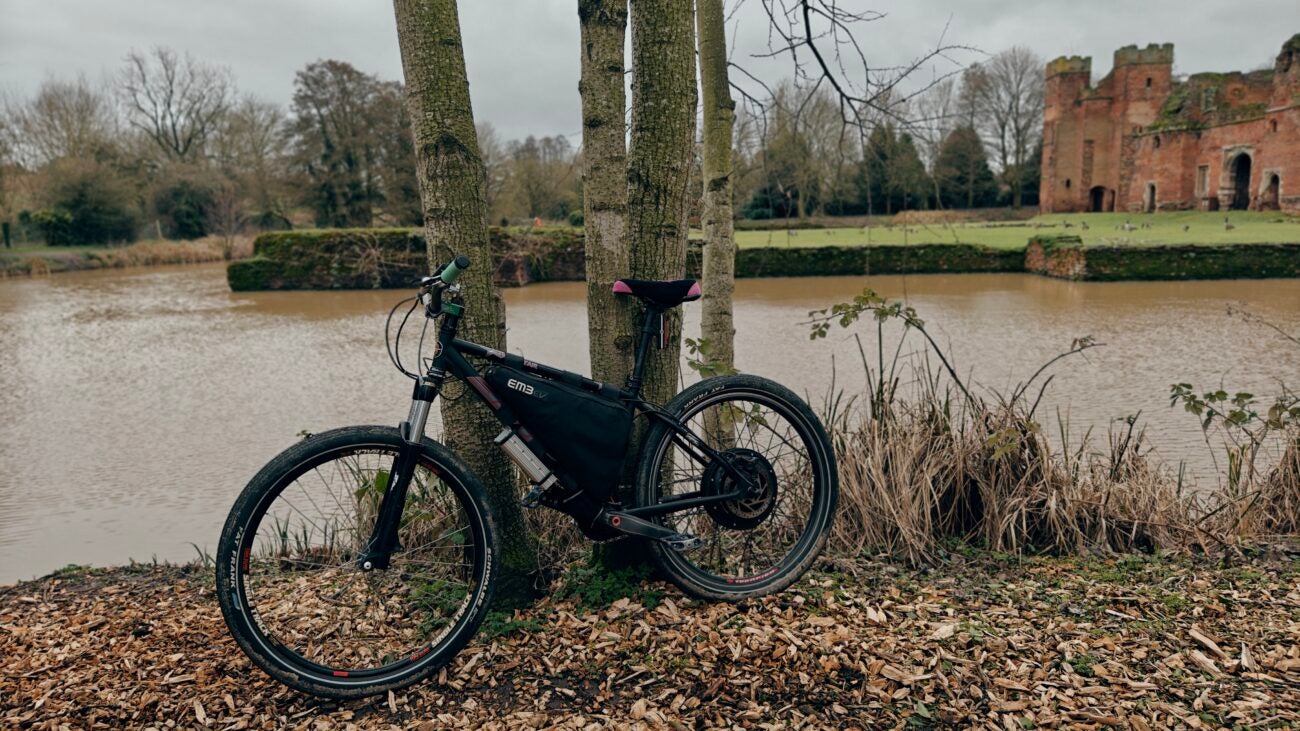



So this generational update is a subtle one. In theory, the increased light sensitivity should allow for fast shutter speeds in low-light conditions, but you’d be hard-pressed to see much of a difference in practice.
What really impressed me was the 3x telephoto. It has one of the largest sensors of any periscope camera, and the results are brilliant. There’s natural compression from the longer focal length and authentic bokeh produced by the wide aperture and the large sensor. In certain conditions, you could easily be fooled into thinking photos from this camera were taken with a professional mirrorless camera, rather than a smartphone.





The ultrawide and 6x provide a little less of that “wow factor”, but they are very capable in their own right, and very useful focal lengths to have in your arsenal. Oppo’s excellent image processing, tuned in collaboration with Hasselblad, ensures that you get natural life-like colours and excellent dynamic range across the board.
The selfie camera is solid, too. I was really pleased to see autofocus, as it’s still a rarity on flagship smartphones, although the Galaxy S24 Ultra and Pixel 8 Pro are working to change that. In practice, it means your selfies are always tack-sharp, whether solo or in a group. You also get three zoom levels to choose from in the camera app, which can be handy if you’re trying to squeeze the whole crew into frame.

The portrait mode works excellently, both with humans and animals, and I was surprised at the accuracy that it cut around wisps of hair. It’ll still trip up from time to time, but it’s one of the better portrait modes, and it’ll even work fairly reliably with fast-moving subjects, too.
At night, the large main sensor and 3x are your best options, as they can keep motion blur at bay using their larger sensors. However, all lenses work quite well with night mode activated, with plenty of detail and very little noise.




For video shooting, you can capture at up to 4K 60fps on all of the cameras, but there’s no 8K option. Video stabilisation is solid and the microphones sound quite good, too.
The native camera app is very photo-centric and was lacking a few video options that I’m used to seeing on camera-focused flagships, like the ability to pair a Bluetooth microphone. Still, videos look great, and most users won’t be looking for these advanced features.
Performance
- Qualcomm Snapdragon 8 Gen 3
- 12GB/16GB LPDDR5X RAM
- 256GB/512GB UFS 4.0 storage
The Oppo Find X7 Ultra is powered by Qualcomm’s current flagship chip, the Snapdragon 8 Gen 3, and that’s paired with 16GB of RAM and 512GB of storage on my test model. It’s also available with 12GB of RAM and 256GB of storage.
As we know from our testing of other current flagships, like the Samsung Galaxy S24 series, the Snapdragon 8 Gen 3 is a seriously powerful chip, and it continues to impress here. In general, the phone feels very speedy and responsive, apps always open quickly and it’ll happily multitask on the spacious display.
You can run almost any game at maxed-out settings, and while it will get a little warm in the process, I never found it heating up to an uncomfortable degree. It powered through some lengthy Genshin Impact sessions without breaking a sweat.
In benchmarks, it performs as well as expected, but GFXBench seemed to be locked to 60fps no matter what I tried. It’s an issue we’ve seen on other devices, like the RedMagic 9 Pro, but it doesn’t affect real-world use.
There’s a game overlay that can be accessed by swiping from the left side of the screen while a game is running, and it’s quite comprehensive. It includes power modes, mistouch prevention, network optimisation, notification blocking and more. Some elements aren’t translated and will display in Chinese, even with the device language set to English, which is a problem throughout the OS. So there’s a chance that this game overlay is more capable than I realise, but I can’t read all the options.
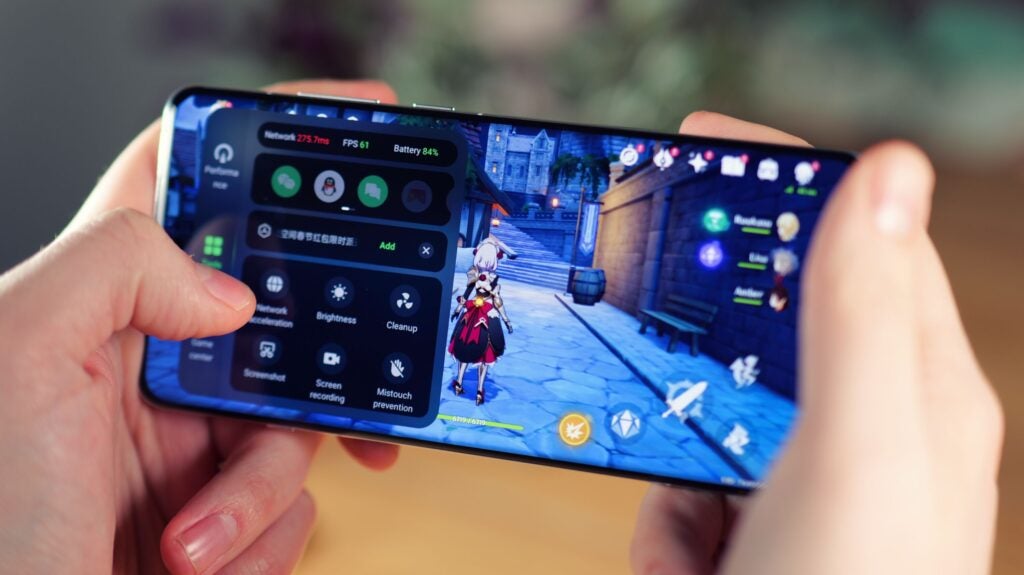
The Oppo Find X7 Ultra has stereo speakers that are positioned on the top and bottom of the phone. When held horizontally, the left speaker sits toward the bottom, and the right speaker towards the top. In practice, this means that you’re almost always muffling one speaker while playing a game or watching full-screen content. However, it’s not an issue when held vertically.
Aside from this niggle, the speakers are very impressive. They’re plenty loud, and there’s more bass than you’ll find on most phones. It’s great for gaming and Netflix content, and music sounds pretty good too. There’s a tiny bit of distortion at max volume, but it quickly goes away if you take the volume down a notch or two.
Software
- ColorOS 14 based on Android 14
- Play Store needs sideloading
- Bloatware and poor localisation
If you can’t tell already, I really like this phone, but it’s with the software that the love affair starts to sour. As mentioned in the introduction, the Oppo Find X7 Ultra hasn’t been launched internationally, and it likely never will be. This means that to get your hands on one, you need to import it from China, and the version of ColorOS that it runs is designed for the Chinese market.
Google Mobile Services are disabled by default, and there’s no Play Store either. It’s not much of a hassle to get all the Google goodies, though, you just need to enable GMS in the settings menu and sideload the Play Store.
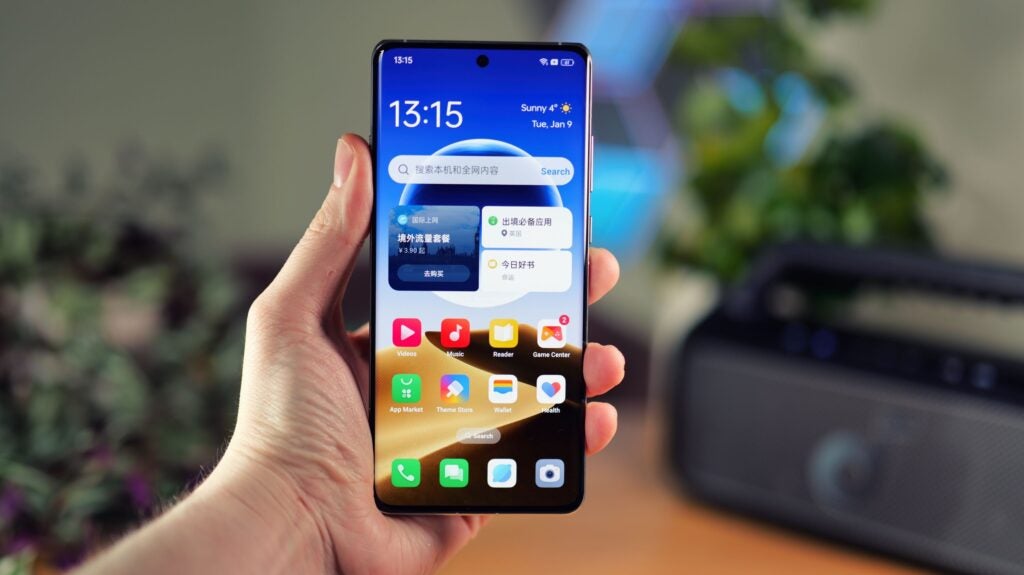
Once that’s done, things work just about as you’d expect. I noticed a few oddities, like sometimes I wouldn’t get Gmail notifications, but this could be down to battery optimisation, as much as anything else. These measures are pretty extreme by default, so you have to go into the settings and disable optimisation for apps that you want reliable notifications from. It’s a bit of a pain.
There’s also a lot of bloatware installed, and it’s almost all Chinese language, so you aren’t likely to want it. But, you can at least uninstall everything, it’s just an irritating process to go through on such a high-end device.
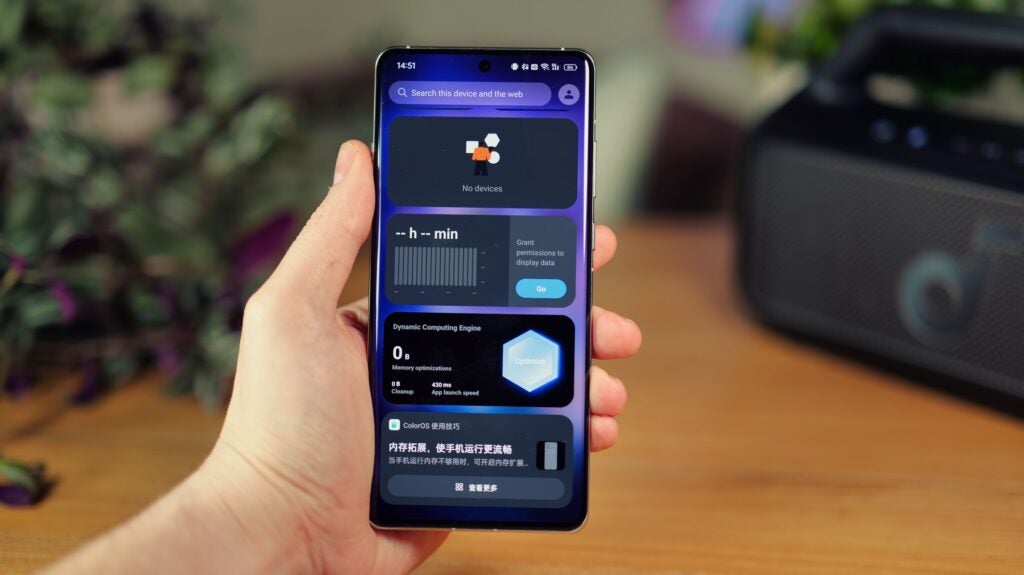
During setup, you can select the English language and for the most part, everything displays in English. However, you’ll often run into untranslated areas, both in the OS and in system apps like the gallery. It can make navigation a little jarring and all but the most dedicated fans of the hardware are going to get frustrated.
There’s some AI functionality built in, as is customary in 2024, but I don’t really know what it does, because that’s also in Chinese. I kept long-pressing the lock button to bring up Google Assistant, out of habit, but you don’t get Google Assistant here, you get Oppo’s Breeno AI assistant, which is all in Chinese, and there doesn’t seem to be a way to change that.
Battery life
- 5000 mAh battery
- 100W wired fast charging
- 50W wireless charging
The Oppo Find X7 Ultra has a 5000 mAh battery that supports up to 100W fast charging, and the charger comes included in the box. It also supports up to 50W wireless charging if you have the right AirVooc charger.

I bought this wireless charger a while back thinking it would work with my Vivo X90 Pro. It didn’t, but it’s awesome to use with this phone. You can just chuck it on the stand when you’re at your desk and it charges faster than many phones do with a wire, it’s so convenient.
The battery life is solid, and the Oppo Find X7 Ultra comfortably saw me through an average day’s use with battery left to spare. If you’re shooting lots of pictures, or playing games, then it’ll drain faster but it still just about got me to bedtime.
Charging with the included adapter is lightning fast, and will get you from fully flat to 100% in less than half an hour, while a 50% charge takes just over 10 minutes. With speeds like this, battery life becomes less of a concern, so long as you’ve got the charger with you.
Latest deals
Should you buy it?
You want one of the best camera systems around
With dual periscope lenses and larger high-resolution sensors, the Oppo Find X7 Ultra is one of the most impressive photographic performers on the market today.
You want something with high compatibility and ease of use
The software is designed for the Chinese market and using it elsewhere will inevitably lead to compatibility and localisation frustrations.
Final Thoughts
The Oppo Find X7 Ultra is a stunning phone that offers the complete package, beautiful design, exceptional cameras and tonnes of power. It’s a real shame that it’s unlikely to launch in Europe, as it could prove to be one of the best smartphones of the year.
As it stands, though, buyers will have to import from China, and make do with software that’s not designed for the Western market. I didn’t run into any massive issues during my testing, but there were constant small frustrations, and it ultimately felt like a relief when I switched back to my usual phone. This route is only for the most dedicated fans, everyone else will have a better time with an internationally released phone.
A compelling alternative is the Vivo X100 Pro, which has been launched globally, and eliminates these software frustrations. It’s still not available in the UK, but it has begun to hit the shelves in selected European countries. This phone trades blows with the Oppo Find X7 Ultra in performance and photography, but it can’t quite match the charming looks of the Oppo, at least in my opinion. And for more options, make sure to check out our Best Smartphone guide.
How we test
We test every mobile phone we review thoroughly. We use industry-standard tests to compare features properly and we use the phone as our main device over the review period. We’ll always tell you what we find and we never, ever, accept money to review a product.
Find out more about how we test in our ethics policy.
Used as a main phone for over a week
Thorough camera testing in a variety of conditions
Tested and benchmarked using respected industry tests and real-world data
FAQs
The Oppo Find X7 Ultra supports up to 50W wireless charging if you have Oppo’s AirVooc charger. Otherwise, it will charge wirelessly at standard speeds.
Oppo has not announced any plans to launch the Find X7 Ultra outside of China. The Find X6 Pro didn’t get an international launch, either.
The Oppo Find X7 Ultra has an IP68 rating. This means it’s water resistant in fresh water up to a depth of 1.5 metres for up to 30 minutes.


